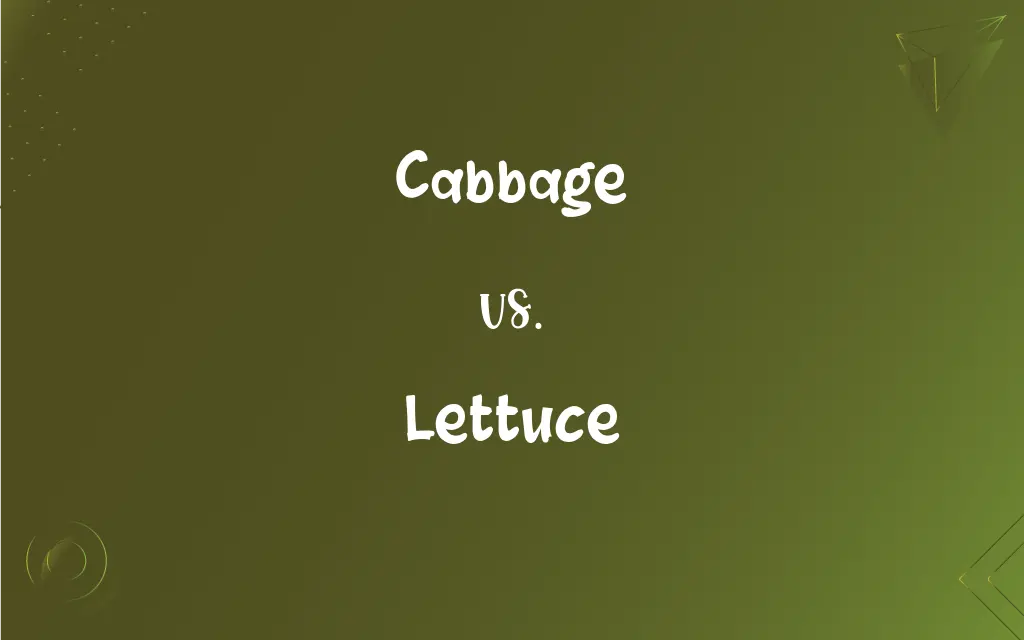Cabbage vs. Lettuce: What's the Difference?
Edited by Janet White || By Harlon Moss || Updated on October 25, 2023
Cabbage is a dense-leaved vegetable; lettuce is a light, leafy green.

Key Differences
Cabbage, originating from Europe, is a dense-leaved vegetable often grown for its heads. Lettuce, on the other hand, is a light, leafy green that has been cultivated for its leaves. Cabbage often forms a hard, compact head, making it suitable for dishes like coleslaw and sauerkraut. Lettuce, in contrast, has softer leaves, making it ideal for salads and sandwiches.
Both cabbage and lettuce are rich in vitamins and nutrients, but their profiles differ. Cabbage contains vitamin C and K, and is particularly known for its cancer-fighting properties. Lettuce, specifically romaine, offers vitamins A, C, and K, and is a great source of folate. Cabbage tends to have a stronger and sometimes bitter taste, while lettuce is milder and can be slightly sweet or bitter depending on the variety.
When it comes to culinary uses, cabbage is often cooked or fermented, enhancing its flavors. Lettuce is generally consumed raw, offering a fresh and crisp texture to various dishes. Both cabbage and lettuce come in different varieties, with colors ranging from green and red to purple, each bringing a unique taste and texture to the table.
In terms of storage, cabbage, due to its tougher exterior, can be kept for longer periods without wilting. Lettuce, being delicate, requires more careful handling and is best consumed fresh to maintain its crispness.
Comparison Chart
Origin
Europe
Ancient Egypt
ADVERTISEMENT
Texture
Dense and compact
Light and leafy
Culinary Use
Often cooked
Usually raw
Nutritional Profile
Rich in vitamin C & K
Rich in vitamins A & K
Storage Duration
Longer
Shorter
Cabbage and Lettuce Definitions
Cabbage
A plant grown for its edible heads.
Cabbage can be green, red, or purple in color.
ADVERTISEMENT
Lettuce
A plant cultivated for its edible leaves.
Romaine and iceberg are popular varieties of lettuce.
Cabbage
A dense-leaved vegetable.
She added cabbage to the stir-fry for extra crunch.
Lettuce
A light, leafy green vegetable.
She topped her sandwich with fresh lettuce.
Cabbage
Often used in coleslaw or sauerkraut.
He fermented the cabbage to make homemade sauerkraut.
Lettuce
A source of vitamins A, C, and K.
Consuming lettuce can contribute to your daily vitamin intake.
Cabbage
A cruciferous vegetable with potential health benefits.
Incorporating cabbage into your diet can offer numerous health advantages.
Lettuce
Commonly used in salads and sandwiches.
Lettuce adds a refreshing crunch to burgers.
Cabbage
A source of vitamins C and K.
Eating cabbage is good for boosting your immune system.
Lettuce
A vegetable with high water content.
Lettuce can help hydrate you during hot days.
Cabbage
Any of several forms of a vegetable (Brassica oleracea var. capitata) of the mustard family, having a globose head consisting of a short stem and tightly overlapping green to purplish leaves.
Lettuce
Any of various plants of the genus Lactuca of the composite family, especially L. sativa, cultivated for its edible leaves.
FAQs
What's the primary difference between cabbage and lettuce?
Cabbage is a dense-leaved vegetable, while lettuce is a light, leafy green.
Which is crunchier, cabbage or lettuce?
Cabbage typically has a crunchier texture than lettuce.
Are both cabbage and lettuce used in salads?
Yes, but lettuce is more commonly used for salads, while cabbage is often cooked.
Do both cabbage and lettuce have medicinal properties?
Both have nutritional benefits, with cabbage known for its cancer-fighting properties.
Are cabbage and lettuce high in fiber?
Both contain dietary fiber, but cabbage usually has more.
Can you cook both cabbage and lettuce?
Yes, but cabbage is more commonly cooked, and lettuce is typically eaten raw.
Are cabbage and lettuce the same thing?
No, they are distinct vegetables with different textures and uses.
Which has a longer storage duration, cabbage or lettuce?
Cabbage can be stored longer than lettuce.
Which has more vitamin C, cabbage or lettuce?
Cabbage generally has a higher vitamin C content than lettuce.
Can you ferment both cabbage and lettuce?
Cabbage is commonly fermented to make sauerkraut, while lettuce isn't typically fermented.
Which is more hydrating, cabbage or lettuce?
Lettuce, due to its higher water content.
Can I use cabbage in place of lettuce for a salad?
Yes, but expect a denser and stronger-tasting salad.
Which is milder in taste, cabbage or lettuce?
Lettuce usually has a milder taste compared to cabbage.
Where did cabbage and lettuce originally come from?
Cabbage originates from Europe, and lettuce from Ancient Egypt.
How do I store cabbage and lettuce?
Cabbage is best stored in a cool, dry place; lettuce should be refrigerated.
Is red cabbage a type of lettuce?
No, red cabbage is a type of cabbage.
Can I grill both cabbage and lettuce?
Yes, both can be grilled, but grilling lettuce is less common than grilling cabbage.
Do both cabbage and lettuce come in different colors?
Yes, both can range from green to red or purple.
Are cabbage and lettuce good for weight loss?
Both are low in calories and can be part of a healthy weight loss diet.
Is iceberg a type of cabbage or lettuce?
Iceberg is a type of lettuce.
About Author
Written by
Harlon MossHarlon is a seasoned quality moderator and accomplished content writer for Difference Wiki. An alumnus of the prestigious University of California, he earned his degree in Computer Science. Leveraging his academic background, Harlon brings a meticulous and informed perspective to his work, ensuring content accuracy and excellence.
Edited by
Janet WhiteJanet White has been an esteemed writer and blogger for Difference Wiki. Holding a Master's degree in Science and Medical Journalism from the prestigious Boston University, she has consistently demonstrated her expertise and passion for her field. When she's not immersed in her work, Janet relishes her time exercising, delving into a good book, and cherishing moments with friends and family.
































































